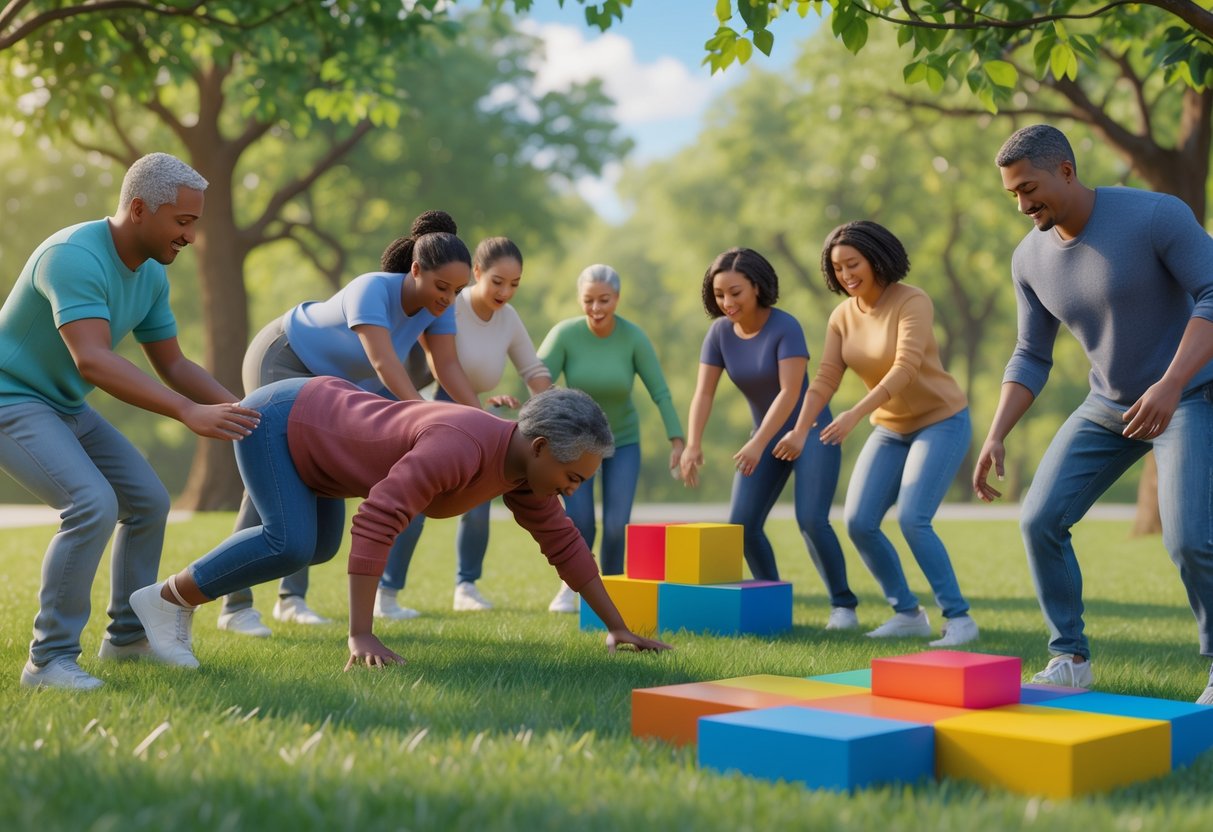Trust Exercises: Proven Activities to Build Connection & Teamwork
Updated On: October 23, 2025 by Aaron Connolly
What Are Trust Exercises?
Trust exercises are activities that help people strengthen their relationships through shared experiences and open communication.
These exercises create spaces where people can be vulnerable and build confidence in each other by taking on specific actions or challenges together.
Definition and Purpose
Trust exercises help people form stronger connections.
Some activities focus on simple communication games, while others involve physical challenges that push people to cooperate.
The main goal? Create positive experiences as a team.
When we face challenges together, we start to rely on each other more.
That’s how we lay the groundwork for better relationships.
Trust-building activities do a few important things:
- Break down barriers between team members
- Create shared moments that bond people
- Teach us to communicate more openly
- Build confidence in each other’s abilities
- Help groups work better together
Research points out that trust grows when people share vulnerable moments.
Trust exercises give us those moments, but in a safe, controlled way.
That makes it easier to build trust without risking too much in real-world situations.
Core Principles of Trust Activities
All good trust exercises follow a few basic rules.
The first is creating psychological safety.
Everyone needs to feel safe before they can open up.
Eight pillars guide trust-building activities:
- Clarity – Make instructions simple and straightforward
- Compassion – Show care for people’s feelings
- Character – Stick to good values
- Competency – Build confidence in each other’s skills
Consistency really matters here.
We can’t just do one trust exercise and expect magic.
Regular practice helps these changes stick and makes people relate to each other differently.
Connection comes from shared experiences, not just talk.
The best trust exercises get people working together toward a common goal.
Over time, this kind of teamwork naturally builds stronger relationships.
Types of Trust Exercises
Trust exercises usually fall into three main groups.
Some focus on communication—helping people share thoughts and feelings more openly.
These might include sharing stories or talking about values.
Physical trust activities get people moving.
Think of the classic “trust fall,” or challenges where team members need to support each other physically.
Common types include:
- Verbal sharing exercises – storytelling, talking about fears or goals
- Physical challenges – trust falls, blindfolded walks, team lifting
- Problem-solving tasks – group puzzles, escape room games
- Creative projects – vision boards, team art, building something together
Emotional trust activities dig into feelings and personal experiences.
Eye gazing or sharing vulnerabilities can help people connect on a deeper level.
Each type has its own way of working, but they all aim for the same thing.
They let people show they’re reliable and that they care.
That’s the core of real trust in any relationship.
The Science of Building Trust
Trust isn’t just a warm fuzzy feeling—it’s grounded in brain chemistry and psychology.
Knowing how trust forms helps us use better strategies to strengthen our relationships.
Why Trust Matters
Trust shapes every part of our relationships.
When we trust someone, our brains release oxytocin—a hormone that helps us bond.
Research says trust and love go hand in hand.
You really can’t have healthy relationships without trust.
Studies show that people in trusting relationships feel less stress and enjoy better mental health.
Trust makes teamwork possible.
When we trust our teammates, we share ideas more freely.
We take risks together and back each other up during tough times.
Physical benefits of trust:
- Lower blood pressure
- Less stress
- Better sleep
- Stronger immune system
Without trust, things fall apart fast.
People get guarded and stop sharing important info.
That creates a cycle—less communication leads to even less trust.
Key Elements of Trust
Trust rests on eight core pillars.
Each one matters for healthy relationships.
Clarity means being direct and honest.
People trust what they understand.
If messages get confusing or vague, trust takes a hit.
Compassion shows we care about others, not just ourselves.
Empathy makes people feel safe.
They know we’ll take their feelings into account.
Character means living by our values, even when it’s tough.
People notice when we do the right thing.
That’s how we earn respect and reliability.
Competency is about having the skills to back up our words.
People trust us more when we show we know what we’re doing.
A growth mindset helps us keep getting better.
| Trust Element | What It Means | How to Build It |
|---|---|---|
| Commitment | Dedication to the relationship | Show up consistently |
| Connection | Building bonds through shared experiences | Spend quality time together |
| Contribution | Following through on promises | Match actions to words |
| Consistency | Reliable behaviour over time | Maintain steady patterns |
Levels of Trust Development
Trust doesn’t happen all at once—it grows in stages.
Knowing these levels helps us build stronger relationships, one step at a time.
Surface trust comes first.
That’s about keeping small promises, like showing up on time.
We show we’re dependable in everyday situations.
Functional trust grows when we work together.
We prove our competence and good judgment.
People learn they can count on us for what we do.
Emotional trust goes deeper.
Here, we share vulnerabilities and personal stuff.
We feel safe being ourselves around certain people.
At the deepest level, there’s unconditional trust.
That means believing in someone’s character, even when their actions don’t make sense.
Trust can get broken at any stage:
- Breaking small promises hurts surface trust
- Poor performance damages functional trust
- Betraying secrets ruins emotional trust
- Character flaws can wreck unconditional trust
Building trust takes time and a lot of positive interactions.
Every good experience adds to our trust account with someone.
If trust gets broken, it’s not the end—but recovery takes real effort.
The person who broke trust needs to own up, commit to change, and prove it with new actions over time.
Benefits of Trust Exercises
Trust exercises can really change how team members work together and support one another.
These activities lower workplace stress and help people communicate better and feel more empathy for each other.
Improved Communication Skills
Trust exercises help us communicate more clearly and listen better.
When we try activities like back-to-back drawing or trust walks, we have to give clear instructions and really pay attention.
These exercises show us how easily we can misunderstand each other.
We learn to ask questions and double-check that we understand before moving forward.
Active listening comes naturally during trust activities.
Team members practice focusing on what their partner says, without distractions.
Some exercises make us communicate without visual cues.
That pushes us to be more specific and careful with our words.
The habits we build during trust exercises spill over into everyday work.
Teams often report clearer discussions and fewer misunderstandings after doing these activities regularly.
Enhanced Teamwork
Trust exercises show how everyone’s strengths help the group succeed.
Activities like escape rooms or problem-solving challenges let different people lead at different times.
We learn to count on our teammates’ expertise instead of trying to control everything ourselves.
That creates healthier team dynamics, where everyone pitches in.
Physical trust activities like the human knot teach us that patience and coordination pay off.
Teams that rush or ignore input usually struggle more than those who work together step by step.
Trust exercises sometimes reveal hidden talents.
Someone who’s quiet in meetings might shine when leading a blindfolded activity.
These shared moments stick with us.
We remember facing challenges together, and that confidence carries into future projects.
Greater Empathy and Understanding
Trust exercises help us see things from our coworkers’ perspectives.
When we guide a blindfolded teammate through obstacles, we experience what it’s like to depend on someone else.
Personal story sharing lets us hear about the experiences that shaped our colleagues.
Knowing someone’s background makes it easier to understand their style and motivations.
We often discover our teammates face similar struggles and doubts.
That shared vulnerability brings people closer and lowers competition.
Trust exercises remind us that what we say and do affects others.
We become more aware of our tone, body language, and the emotional impact of our words.
Teams build stronger emotional intelligence by doing these activities.
We get better at spotting when someone needs help and figuring out how to support them.
Reduction of Anxiety and Stress
Trust exercises help teams feel safer psychologically.
When we know our coworkers will back us up, work feels less stressful and more open.
Research says employees in high-trust workplaces feel 74% less stress than those in low-trust environments.
Trust activities play a direct role in making that happen.
Physical trust exercises help us get comfortable with vulnerability.
Starting small and building up makes it easier to take risks and ask for help.
We learn that mistakes in a supportive group lead to learning, not punishment.
That takes the edge off perfectionism and fear of failing.
Regular trust-building gives teams a way to work through tension before it turns into conflict.
Essential Trust-Building Activities
These core activities focus on physical trust, creative collaboration, guided support, and group dynamics.
Each one targets a different part of team building and is pretty simple to set up.
Trust Fall
The trust fall is probably the most famous trust-building activity out there.
One person stands with their back to a partner, closes their eyes, and falls backward.
The partner must catch them—no hesitation.
Basic Setup:
- Two people stand about arm’s length apart
- The person falling keeps their body straight
- The catcher stands ready with a solid stance
- Start with small leans before trying a full fall
This exercise creates instant physical trust.
The person falling has to let go, while the catcher proves they’re reliable.
Safety Tips:
- Teach everyone how to catch safely
- Begin with short distances
- Make sure catchers can handle the weight
- Use spotters for bigger groups
The trust fall works well for teams that need to break the ice quickly.
It’s an experience people remember long after the exercise ends.
Back-to-Back Drawing
This one’s all about communication.
Teammates sit back-to-back.
One describes a simple drawing, and the other tries to recreate it—no peeking.
How It Works:
- Give one person a basic shape or object to describe
- Their partner gets paper and a pencil
- No questions allowed in the first round
- Compare the drawings and talk about what worked (or didn’t)
Back-to-back drawing shows just how differently people can interpret instructions.
Teams realize the value of being clear and specific, not just assuming things.
Variations:
- Allow questions in the second round
- Switch roles halfway through
- Try more complicated images
- Add a time limit for a little pressure
You’ll spot different communication styles right away.
Some people give too many details, others skip key steps.
Trust Walk
The trust walk pairs a blindfolded person with a guide.
The guide leads their partner through a course using only verbal directions.
Course Setup:
- Set up obstacles with chairs, cones, or tape
- Add turns, steps, or narrow spots
- Double-check that everything’s safe
- Let multiple pairs go at once if you want
Trust walks help people practice active listening and patient guidance.
The blindfolded person has to trust completely.
The guide takes full responsibility for their partner’s safety.
Key Takeaways:
- Clear directions matter
- Rushed instructions lead to mistakes
- Sometimes a reassuring touch helps
- Both roles teach different skills
Let everyone try both roles.
This exercise proves that trust takes effort from both sides—those who trust and those who are trusted.
Willow in the Wind
One person stands in the center of a tight circle formed by 6-8 teammates.
With eyes closed and body straight, they gently sway like a willow tree, while the circle catches and guides them.
Circle Formation:
- Team members stand shoulder-to-shoulder.
- Hands stay at chest height.
- The person in the center begins with small movements.
- The circle gently passes them around.
Willow in the wind builds shared group trust, not just one-on-one reliance.
The person in the middle has to trust several people at once as the circle coordinates to support them.
Progression Steps:
- Start with tiny sways.
- Gradually increase the range of movement.
- Let the center person pick directions.
- Add gentle spinning motions.
This activity works especially well for teams that need to build collective responsibility.
Everyone in the circle must stay alert and work together to keep their teammate safe.
Communication and Honesty Exercises

Building trust through open dialogue actually requires structured activities that nudge people toward truth-telling and supportive interactions.
These exercises help folks practice vulnerability while creating safe spaces for authentic connection.
Two Truths and a Lie
This classic trust-building exercise gets people to share honestly, with a dash of fun.
Each person shares three statements about themselves—two true and one made up.
We usually start with everyone sitting in a circle.
Each participant takes a turn sharing their three statements.
The group then debates which statement they think is the lie.
Example statements:
- “I once ate snails in France”
- “I can speak three languages fluently”
- “I’ve never broken a bone”
The activity works because it nudges people to reveal surprising truths they might not usually share.
After each round, we talk about what made certain statements believable.
This helps everyone understand how trust forms through consistent honesty.
Honesty Practice Challenges
These activities help people practice telling the truth, even when it gets tricky.
We design challenges that start simple and gradually ask for more vulnerability.
Week 1: Daily truth check
- Share one honest feeling each day.
- Admit when you don’t know something.
- Correct small mistakes right away.
Week 2: Difficult conversations
- Address one minor conflict directly.
- Express a genuine concern to someone.
- Ask for help when you need it.
Week 3: Vulnerability practice
- Share a personal struggle.
- Admit to a mistake you made.
- Express appreciation honestly.
We track progress with simple journals.
Participants jot down how honesty affects their relationships and stress levels.
Support Test Activities
These exercises teach people to offer and receive support in a way that feels real.
We focus on creating supportive environments where trust can actually grow.
The listening circle has one person share a challenge while others practice active listening.
Nobody gives advice—just a supportive presence.
Trust falls are still popular because they ask for physical vulnerability.
We start with seated versions before moving to standing ones.
Emotional check-ins happen at the start of each session.
We ask, “How are you really feeling today?” and encourage honest answers.
| Activity | Time needed | Group size | Trust level required |
|---|---|---|---|
| Listening circle | 20 minutes | 4-8 people | Medium |
| Trust falls | 15 minutes | Pairs | High |
| Check-ins | 10 minutes | Any size | Low-medium |
Support isn’t about fixing problems.
Sometimes, the most helpful thing you can do is just believe someone and validate their experience.
Vulnerability and Openness in Trust Building

Sharing personal experiences and creating safe spaces for honest communication forms the backbone of lasting trust in competitive gaming teams.
Building trust with controlled vulnerability helps teammates connect beyond just game mechanics and develop the psychological safety they need for peak performance.
Safe Vulnerability Sharing
Structured chances for team members to share personal experiences can build deeper connections without forcing anyone to overshare.
We suggest starting with low-stakes questions before moving on to more meaningful stuff.
Pet Projects are great for breaking the ice.
Ask teammates about hobbies or passion projects outside gaming.
Most people like talking about what they love.
For a deeper connection, try graduated intimacy levels:
- Level 1: “What skill have you always wanted to learn?”
- Level 2: “What’s one thing you’d change about yourself?”
- Level 3: “What worries you most about competitive gaming?”
These questions let team members choose their comfort level.
No one has to overshare, but those ready for deeper connection can go there.
Childhood memories also help people bond.
Ask about favorite childhood presents or role models.
Nostalgia brings up positive feelings that naturally build trust.
Progressive Openness Exercises
Building openness takes time.
We design exercises that slowly increase comfort levels over several sessions.
Start with professional development discussions.
Watch training videos together and talk about improvement areas.
This opens up vulnerability about gaming skills without getting too personal.
Move to skill-sharing sessions where teammates teach non-gaming abilities.
Maybe someone shows off a cooking trick, while another explains photography basics.
These sessions build confidence and reveal hidden talents.
Empathy walks are a more advanced way to build openness.
Pair teammates for walks and let them discuss deeper questions about gaming goals, fears, and motivations.
Walking makes the conversation flow more naturally.
| Exercise Type | Trust Level | Time Needed | Best For |
|---|---|---|---|
| Pet projects | Beginner | 15 minutes | New teams |
| Skill sharing | Intermediate | 30 minutes | Established teams |
| Empathy walks | Advanced | 45 minutes | Close teammates |
Managing Boundaries
Vulnerability exercises work best with clear boundaries.
We set ground rules before any trust-building activity begins.
Consent is always key.
Let team members pass on questions or tweak prompts if needed.
Never pressure anyone to share beyond their comfort zone.
Create confidentiality agreements within the team.
What’s shared during trust exercises stays in the group unless someone asks for help with serious issues.
Watch emotional responses during activities.
If someone looks uncomfortable, change the topic or take a break.
Trust building should feel challenging, but not overwhelming.
Establish time limits for sharing.
Two minutes per person usually works well and keeps things fair.
Check in afterwards.
If someone shared something especially personal, follow up with them.
That kind of care matters way beyond just gaming.
Problem-Solving and Team-Building Activities

These activities challenge teams to work together under pressure.
They build trust through shared problem-solving experiences.
Combining strategic thinking with clear communication strengthens workplace relationships.
Escape Room Challenges
Escape rooms throw teams into intense problem-solving scenarios.
Everyone needs to trust each other’s insights and skills to succeed.
We’ve seen escape rooms break down workplace barriers fast.
Time pressure pushes people to communicate clearly and listen to every idea.
Key benefits:
- Test team dynamics under pressure.
- Build confidence in teammates’ problem-solving skills.
- Encourage creative thinking and collaboration.
Most escape rooms fit 4-8 people per session.
Virtual escape rooms work well for remote teams.
Budget about £20-30 per person for in-person rooms or £10-15 for online ones.
That shared experience of either winning or losing together forges lasting bonds.
Teams often discover hidden talents in quieter members who shine under pressure.
Scavenger Hunts
Scavenger hunts make teams split up tasks based on strengths.
They have to keep communicating to succeed.
We like hunts that mix physical tasks with mental puzzles.
Add challenges that require asking strangers for help or snapping group photos.
This gets everyone out of their comfort zone together.
Effective scavenger hunt elements:
- Mix of solo and group challenges.
- Time limits to keep things moving.
- Tasks for different skill sets.
- Regular check-ins between team members.
Most hunts take 2-4 hours.
Apps like GooseChase help, or you can make your own list.
Costs range from free (DIY) to about £15 per person for organized events.
The main point is to create situations where teammates must trust each other’s judgment and follow through.
Group Decision-Making Games
Decision-making games put teams in scenarios where they must reach consensus under pressure.
These activities show how groups handle disagreement and build trust in collective judgment.
“Desert Survival” and “Lost at Sea” are favorites.
Teams rank items by importance, first alone and then together.
The process reveals how teams navigate different opinions and build confidence in group decisions.
Popular formats:
- Ranking exercises with tight deadlines.
- Resource allocation challenges.
- Moral dilemma discussions.
- Strategic planning simulations.
Any group size works, and you don’t need much in the way of materials.
Most sessions last 30-60 minutes.
Focus on the process and discussion, not just the “right” answer.
Teams learn to trust the group’s wisdom while respecting individual views.
This transfers directly to workplace decision-making.
Rebuilding Trust After It’s Broken

Breaking trust stings, but it doesn’t have to be the end.
The way back takes real commitment, steady actions, and patience from everyone.
Steps for Rebuilding Trust
Everything starts with total honesty about what happened.
We can’t fix what we won’t face.
The person who broke trust needs to take full responsibility.
No dodging or blaming.
A good apology admits the behavior, acknowledges the hurt, and lays out real changes.
Actions speak louder than words.
Trust rebuilds through consistent behavior over time, not flashy gestures.
Small, steady actions prove commitment way better than big promises.
Communication matters a lot during this phase.
Regular check-ins let both sides express feelings without judgment.
These chats might feel awkward, but they’re essential.
Set realistic expectations.
Trust doesn’t come back overnight.
Some relationships need months or even years to fully heal, depending on what happened.
Addressing Past Issues
Rebuilding trust means digging into root causes, not just patching things up.
We need to figure out what led to the breach in the first place.
Look at triggers, circumstances, and underlying issues.
If someone lies because they fear conflict, we have to address both the lying and the fear.
Past traumas can make trust harder.
Someone who’s been hurt before might need more time to forgive.
Acknowledging those experiences shows empathy.
New boundaries help.
Both sides should talk about what’s okay moving forward and what’s not.
Sometimes, getting a counselor or mediator involved helps when emotions get heated.
They can offer strategies we might not think of ourselves.
Restoring Confidence in Teams
Team trust works differently than personal trust.
When trust breaks in a group, everyone’s performance and morale take a hit.
Leaders play a huge role here.
Managers need to model the behavior they expect and address issues quickly.
Transparency is a must.
Teams need clear communication about decisions, changes, and expectations.
Hidden agendas kill trust fast.
Trust-building activities can help teams reconnect.
These might be collaborative projects or structured exercises that encourage openness.
Regular team meetings focused on trust catch problems early.
We need to create spaces where people can voice concerns without fear.
Celebrating small wins together helps, too.
When teams reach goals through cooperation, it reminds everyone that trust leads to success.
Trust Exercises for Different Relationships

Different relationships call for different trust-building approaches.
What works for friends might not suit romantic partners or family members.
Friendship Trust Activities
Building trust in friendships doesn’t have to feel overwhelming. Honestly, the simplest shared experiences often work best.
Try a “vulnerability swap” with a close friend. Take turns sharing something personal you haven’t told anyone else. Maybe start with a silly childhood fear or an embarrassing story. That way, you both ease into deeper sharing.
Plan regular activities that need teamwork. Escape rooms, cooking challenges, or learning a new skill together help trust grow naturally. When you work toward a shared goal, you start relying on each other without really noticing.
Quick trust builders for mates:
- Share personal goals and check in weekly
- Have honest conversations about past conflicts
- Create traditions you both look forward to
- Support each other through tough times
Consistency matters. Show up when you promise. Keep secrets that friends share with you. Those small things stack up and build trust over time.
Couples Trust Exercises
Romantic relationships call for deeper trust-building. Physical and emotional intimacy both need vulnerability.
Eye gazing can feel awkward, but it’s powerful. Sit facing each other and hold eye contact for 2-5 minutes, no talking. Oxytocin gets released, and honestly, the connection feels real.
Create a vision board together about your shared future. Add career dreams, travel plans, and big milestones. It helps align your goals and shows you’re in it for the long haul.
Daily trust practices:
- Share one fear and one hope each day
- Give genuine apologies when you mess up
- Ask how your partner is feeling regularly
- Plan regular date nights without phones
Physical touch matters, too. Set aside time just to cuddle, with zero pressure for anything more. You’ll both feel the stress melt away.
Family Trust-Building Ideas
Family trust works best when everyone gets involved and all ages feel included. Focus on creating positive shared memories.
Host weekly family meetings so everyone can share concerns without judgement. Set ground rules: no interrupting, no criticism. Kids learn their voices matter and that you can solve problems together.
Plan monthly adventures that nudge your family out of the comfort zone. Try new restaurants, visit unfamiliar places, or learn something new as a group. Those shared challenges build trust and make great stories.
Trust-building family traditions:
- Gratitude sharing at dinner
- Annual family camping trips
- Game nights with no screens
- Cooking meals together
Let kids make age-appropriate decisions sometimes, like picking dinner or the movie. It shows you trust their judgment and value their opinions.
Creating a Supportive Environment for Trust

Building trust means more than just doing activities together. We need to set up foundations that make everyone feel safe to be vulnerable and real with their teammates.
Nurturing Psychological Safety
Psychological safety is the heart of any trust-building. Team members need to feel confident they can speak up, make mistakes, and share ideas without fear.
We create this safety by treating mistakes as learning opportunities. When someone struggles, we highlight their effort, not just the result. That simple shift encourages people to take risks and join in for real.
Active listening matters a lot. We show this by keeping eye contact, asking follow-up questions, and repeating what we’ve heard. When people feel heard, they’re way more likely to open up.
Setting clear rules about confidentiality helps too. What gets shared in trust exercises stays in the group unless everyone agrees otherwise. That boundary lets people be authentic.
Establishing Group Norms
Clear ground rules keep things consistent and avoid misunderstandings. We set these norms together at the start of any program.
Essential norms include:
- Respecting each other’s comfort zones
- Speaking for ourselves using “I” statements
- Keeping things confidential
- Giving everyone equal airtime
- Avoiding judgement or advice-giving
We write these down and check back on them regularly. If someone steps outside the norms, we address it quickly and kindly. That keeps the group supportive without shaming anyone.
Regular check-ins let us tweak norms as needed. Every group is a little different.
Encouraging Open Communication
Trust grows when people talk honestly and directly. We try to model this and create moments for real conversations.
Communication skills build with practice. We start with low-risk sharing before moving to deeper stuff. That way, people get more confident and boundaries stay respected.
We teach simple techniques like using “I feel” instead of “you always.” These small changes help keep things productive and reduce defensiveness.
Multiple channels for communication help too. Some people like group talks, some prefer writing or one-on-ones. We try to meet everyone where they’re at.
Regular feedback sessions help us catch breakdowns early, before trust takes a hit.
Measuring Trust Progress and Outcomes

Trust doesn’t magically improve overnight. Tracking progress helps us see if our exercises are working. We need tools that show real results so we can adjust as we go.
Trust Assessment Tools
We’ve got a few solid ways to measure trust in teams. Surveys are the easiest for quick data.
The Trust Index survey asks people to rate statements like “I feel comfortable sharing ideas with my teammates” on a 1-5 scale. Try running these monthly to spot trends.
One-on-one interviews dig deeper than surveys. Ask open questions like:
- When did you last feel really supported by a teammate?
- What would help you trust your team more?
- How comfortable are you giving honest feedback?
We also use observation checklists during meetings and projects. Look for these signs:
| High Trust Signs | Low Trust Signs |
|---|---|
| Open communication | Guarded responses |
| Willingness to admit mistakes | Blame-shifting |
| Collaborative problem-solving | Working in isolation |
| Regular feedback exchange | Avoiding tough conversations |
Anonymous feedback platforms like suggestion boxes or digital tools let people share concerns without fear.
Tracking Trust Growth
We use specific metrics to track trust. Check these areas each month:
Communication frequency shows how often people choose to interact outside required meetings. High-trust teams talk more.
Conflict resolution time measures how quickly teams fix disagreements—from start to finish.
Feedback quality gets better as trust grows. Teams move from vague comments to real, constructive feedback.
Set up a simple tracking sheet:
Week 1-4: Baseline measurements
Week 5-8: Post-exercise assessment
Week 9-12: Follow-up evaluation
Participation rates in trust exercises matter, too. Teams that resist at first often get more engaged as trust builds.
Celebrate small wins. If survey scores go up even half a point, mention it. People notice when progress gets recognized.
Adapting Trust Strategies
Trust grows differently for every team, so we have to stay flexible. If trust plateaus after six weeks, it’s time to switch things up.
Low survey scores on communication? Try more structured sharing exercises—maybe daily check-ins or peer feedback.
Long conflict resolution times mean teams need better frameworks. Introduce mediation or conflict protocols.
We adjust exercise difficulty to match comfort levels. Teams struggling with basic sharing aren’t ready for big vulnerability exercises.
Remote teams need special care. Virtual trust-building needs more touchpoints and creative online ideas.
Keep an eye on individual responses as well as team averages. Some people need extra support or a different approach.
If progress stalls, go back to easier exercises before moving ahead. Sometimes teams need to firm up the basics.
Review your strategy every month. Ask: What’s working? What isn’t? How can we improve?
Frequently Asked Questions

Here are some questions about trust exercises for different groups—work teams, couples, kids, and classrooms. Every group needs activities that fit their comfort zones.
What are some effective trust-building activities for adult teams at work?
Trust walks work surprisingly well. One person closes their eyes and a partner guides them around the office. It builds communication and shows how much teams rely on each other.
Escape rooms naturally create teamwork situations. Teams have to solve puzzles under time pressure, combining different skills.
Problem-solving challenges help, too. Give teams a task like building something with limited supplies. They learn to trust each other’s ideas and abilities.
Short, regular team meetings where people share wins and struggles keep trust growing. Keep them focused and relevant.
Could you suggest some trust exercises that could help strengthen a romantic relationship?
Vulnerability sharing works wonders. Take turns sharing fears or past experiences. It deepens understanding.
Write honest letters to each other about your relationship. Share what you appreciate and what worries you. Read them together—no judgment, just listening.
Try mindfulness together. Meditate or do deep breathing side by side. Being present helps you connect emotionally.
Cook meals together often. It sounds simple, but teamwork in the kitchen builds trust and creates good memories.
How can trust exercises be modified for children to learn the value of trust from an early age?
For kids, trust games need to be fun and simple. Play “Trust Tag”—one child closes their eyes and follows another’s voice. Keep it short and safe.
Try show-and-tell with special objects. Kids bring something meaningful and explain why they love it. They learn to share personal things safely.
Create team art projects. Each child adds a part, trusting others won’t mess it up. It teaches cooperation.
Promise-keeping games help, too. Kids make small promises to each other—like sharing toys or helping clean up—and follow through.
What are fun trust activities that friends can do to enhance their bond?
Truth games are great for friends. Ask questions like “What’s your biggest fear?” or “What made you happiest this year?” Keep it light but meaningful.
Plan activities that need you to depend on each other. Try partner yoga or three-legged races. You’ll laugh and trust will grow.
Share secrets over time. Start with little things. As trust builds, you can share deeper stuff.
Take turns planning surprise activities for each other. It shows you listen and care about their interests.
Can you recommend trust-building exercises that are suitable for leadership teams to improve cooperation?
Leadership teams benefit from activities that reflect real work situations. Role-play tough conversations and practice supporting each other’s decisions.
Try “Two Sides of the Coin.” Each leader shares a strength and a weakness they bring to the group. It builds honest communication.
Set up scenarios where leaders have to make group decisions quickly. Use cases that mimic real challenges. You’ll see how they handle pressure together.
Regular feedback sessions help, too. Leaders discuss each other’s styles and focus on specific behaviors, not personalities.
What sort of trust activities can be incorporated into the classroom to encourage students to work together?
Try group projects with assigned roles—students end up relying on each other’s skills. If you make sure every role actually matters, you’ll stop one student from carrying the whole thing.
Circle time works well too. When students share personal stories (within reason), it really helps build a sense of community. Of course, you’ll need to set some ground rules about listening respectfully.
Partner learning activities are another good option. Students teach each other, so they have to trust their partner to help them understand the topic.
You can also let the class create their own agreements about trust. Ask them what happens if someone breaks those agreements—give them some real ownership.

